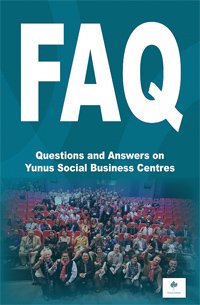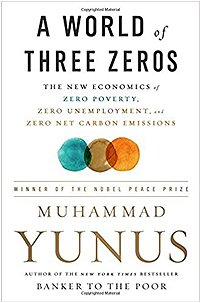It all starts in a village , A short history of microfinance
Anne Perkins offers a historical look at microfinance, placing the work Barclays will do in Katine in context guardian.co.uk
Article history
Katine microfinance history Â
Customers in Bangladesh repaying microloans. Photograph: Karen Kasmauski
In 1974, an economics lecturer at the University of Chittagong, Bangladesh, lent $27 to a group of impoverished villagers. Thirty years later, the lecturer, Muhammad Yunus, won the Nobel peace prize and microfinance become the world's favourite development idea, the silver bullet that will cure world poverty and spread the wealth-creating force of capitalism across the globe. Only last month, Gordon Brown announced more money to help support microfinance institutions (MFIs) in Africa.
Microfinance has a beguiling simplicity and a record of success not just in promoting financial resilience but in achieving other social objectives – reaching the excluded, empowering women and developing the capaccity of small groups of people to take control of their own lives.
Muhammud Yunus founded his Grameen Bank in 1983 to make very small loans – perhaps £15 a time – to the poor and uncreditworthythy. Since then it has loaned about £3 billion to more than six million of the very poorest in Bangladesh and across the Asian sub-continent, yet it remains entirely self-financing. Borrowers' deposits cover the costs.
Although Grameen Bank is now instituting programmes for the destitute, its historical association has been with the slightly less poor, helping them to set up micro-enterprises that provide sustainable family incomes. It is a very slow process. The bank's impact research suggests that each year, only 5% of their clients are lifted out of poverty. Ill health, poor education and natural disasters are the three critical predictors of failure.
It is now experimenting with a holistic approach (where basic medical care is available at the same place the customer would go to repay an instalment of the loan), and offering adult education. It funds 20,000 student loans a year and provides 50,000 scholarships for schooling. It is also trying to find ways of helping creditors survive disaster, whether it is a personal accident or a major flood.
Microfinance is now widely used in Africa, where among its pioneers is Care International UK, Barclays partner in developing financial services for the Katine project. While Grameen Bank is an institution that makes rigorous demands on its borrowers – new borrowers sign up in peer groups to, "the 16 Grameen decisions" (a range of pledges on everything from vegetable growing to no dowries) – Care International builds on the tradditional village savings and loans associations (VSLAs) where a group saves a small amount each month and lends it out for immediate needs at high rates of interest.
At the end of each year, the VSLA's account is reckoned and profits paid out to investors before the group re-forms. It is small-scale, finite and an important tool in helping very poor people meet daily challenges such as the unforeseen medical bill, or an item of school uniform. In Katine, and other areas scarred by recent conflict, these groups can play an important role in rebuilding trust within a community.
At its lowest level, microfinance sees people through the worst of times. It is a form of insurance, of pooled risk among a group of villagers or neighbours where repayment is high because the borrowing is from friends and acquaintances.
At the next level, which many participants never aspire to, it might involve borrowing to start up a small enterprise, or to expand an existing one. Village savings and loan associations are less good for business because of the high interest rates charged and the short term of the loans. Care International's objective is to reach the most excluded and also to enable those who want to graduate into the more formal microfinance sector.
However, the success of microfinance has come under increasing scrutiny as evidence is demanded by donors and governments for the claims made for it as an economic and a social tool. Microfinance is a grown-up global brand now, and some of the shine has worn off.
As long ago as 1997, the Asian-based development analyst Vijay Mahajan was warning that although improving poor people's ability to withstand financial shocks is important, it did not make them less poor in itself. If it is to work as a tool of poverty alleviation, microfinance needs to support business. Yet a majority of people would rather have a safe job than take on the risks of running a business.
Katine - shopkeeper Simon Eebu Katine shopkeeper Simon Eebu. Photograph: Dan Chung
Borrowing can be a cause rather than a cure for problems. People borrow to repay earlier loans and get overwhelmed by debt. Drop-out rates in East Africa have been as high as 60%, although they are much lower in Bangladesh where the Grameen programme operates in a more intensively structured manner. For the poorest, a safe place to save is the first essential. Meanwhile, evidence on the ground suggests that extending credit to the poorest delivers less than when it is targeted at those just above the poverty line. Finally Mahajan argues over-emphasis on microfinance can deter structural investment without which business will not work.
In 2005, the year that the UN dedicated to microfinance, others also stressed the need to begin by helping poor people to save and cast some doubts on the effectiveness of group financing.
Meanwhile the move to regulate and standardise microfinance institutions (MFIs) in order to create the climate where they can play a more formal role in the economy risks jeopardising some of the things they do best â€" reaching the poorest and the disempowered. One study suggested a marked decline in the takeup of loans by women from regulated MFIs.
Care International acknowledges that many people who join village savings and loan groups want nothing more than a safe place to save and access to their money or to small borrowings for emergencies. But a few will want to go further: perhaps first to some form of simple insurance, and then to borrowing for investment.
So as well as setting up VSLAs, the organisation provides expertise and advice to the next level of microfinance institutions, which will be a source of capital for VSLAs ready to expand and wanting to lend at more competitive rates of interest. And to fund that level, it has set up a global organisation, MicroVest. Microfinance has limitations, but it remains one of the most promising ways of tackling poverty.
http://www.guardian.co.uk/katine/2008/jun/03/livelihoods.projectgoals1Â


